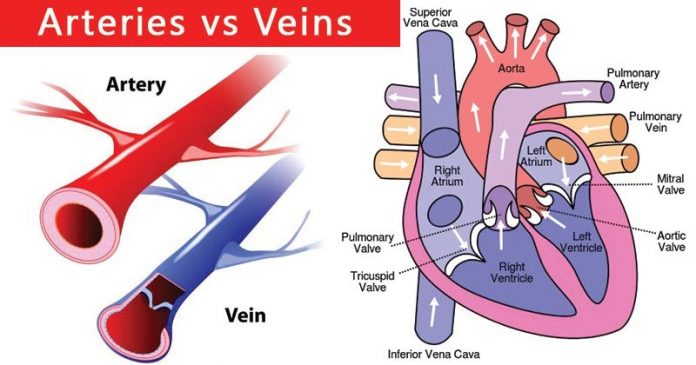The human body comprises enormous veins and arteries. Both veins and arteries are blood vessels. But there are differences in its characteristics and functionality. Blood vessels are indeed the channels that are responsible for the distribution of blood in the human body. There are two tubular systems in the body which are systemic vessels and pulmonary vessels. Let us find out about both types of blood vessels in detail to know the apparent differences about them:
What are Arteries and Veins?

Arteries
The term artery use to define the blood vessels that function to carry the oxygenated blood to the body parts from the heart. These are much thicker than that of the veins and contain pure blood.
Veins
The blood vessels, which characterize by the ability to carry the deoxygenated blood to the heart from various body parts, are veins. They contain blood that is deprived of oxygen.
Color of Blood
Arteries carry pure or oxygenated blood in them, so their blood color is bright red. The bright red color is a clear indication of blood purity. However, contrary to this, the blood color in the veins is dark red. Some of the time, the color of blood in the veins seems blue. But in actuality, it is dark red. The appearance of blue color is due to the optical illusion and indicates the loss of oxygen.
Types of Arteries and Veins
Arteries come in different types, which are composed of multiple coats. These include inner, middle, and outer coats. The primary type of arteries are arterioles, muscular arteries, and elastic arteries. The minor divisions that transport oxygenated are known as arterioles. However, medium-sized arteries are muscular arteries. These help in drawing blood to the resistance vessels from elastic arteries. Arterioles and small arteries include in muscular arteries. They play a distributing role in the body. The arteries that comprise a middle thick layer is papular as an elastic artery. These are also known as conduit arteries or conducting arteries.
Types of Veins
Four significant categories of veins are systemic veins, pulmonary veins, superficial veins, and deep veins. The veins that are located all over the body are systemic veins. These are present in the trunk, arms, neck, legs, and other body parts. Pulmonary veins are two in number, which run to the left and right one. The type of veins that are visible and located near the skin’s surface are superficial veins. These are the veins that do not comprise any corresponding arteries. However, the type of vein which is present within the muscle tissue is a deep vein. These contain the corresponding artery.
Also read: Difference between breathing and respiration
Pulmonary arteries Vs. Pulmonary Veins
The Pulmonary vessels are the ones that lead the transport of deoxygenated blood to the lungs from the heart, while all the veins transport low oxygenated blood in the body except the pulmonary veins. Pulmonary veins are the ones that carry oxygenated blood. Most often, people make mistakes in comprehending this concept. Pulmonary arteries are the ones that carry





![4 Recommended “Cassette Gas Stoves” Easy to carry, ideal for spot heating [2021 latest version] Portable gas stove](https://23premiumgames.com/wp-content/uploads/2021/06/UT8V67jXZVXXXagOFbXz.jpg)
![6 Recommended manufacturers for PC monitors [2021 version] Best buy computer monitors](https://23premiumgames.com/wp-content/uploads/2021/06/acer-predator-x34a-best-monitor-malaysia.jpg)
